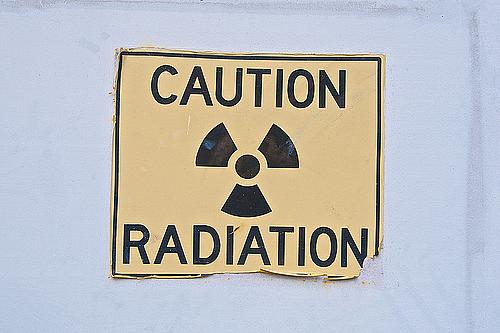Ecological Anxiety: Radiation Fears Stoked by History, Politics, and Propaganda

The crowd asking questions about radiation in Magnuson Park quickly became agitated.
“I don’t want to have to be an investigative reporter to find out what is going on at the park!” a woman said.
“How do we stop the freight train that we’re on and change course?” asked another.
The anxiety levels were high and getting higher at the impromptu Q&A session last week at the Seattle park where radioactive materials were recently found, left behind by the U.S. Navy when it closed it up shop in the 1970s. I went to the meeting expecting a formal hearing. What I found was a lot of posters put up by the Navy and the Washington State Department of Ecology in an attempt to explain what had happened and what was going to be done to remedy the situation.
The fear that ran through the room was not unlike the radiation itself – permeating everything, more intense in some areas than others, and hard to trace. I say hard to trace because everyone was coming to the room with their own preconceptions about what a radiological threat means. To understand the nature of a threat like buried radiation in a park, it helps to pause for a minute and think about the sacred values of the people feeling threatened. Part of the threat is physical, and I will detail that threat to the best of my ability in future posts. But part of the damage being done is psychological and should not be dismissed.
Cold warriors reheated
Given the average age of the roughly 100 people in the room – mid-50s – there was clearly a strong strain of Cold War unease. For people born after the Berlin Wall came down, it’s a little difficult seeing through that same lens. (I watched enraptured by the TV scenes of crowds gleefully breaking the wall apart with hammers and their bare hands.) Kids growing up in Montana, Wyoming, South Dakota, and other Western states grew up around hundreds of nuclear missile silos. And we were fed a steady diet of “the Russians are coming.” We get it. Nuclear weapons and the associated radiation are very scary.
It doesn’t help that one of the biggest nuclear disasters in recent memory happened in the former Soviet Union. For the Cold War generations, it represents the nightmare of the Russian threat coming to life in an invisible radiation cloud instead of a mushroom cloud.
Washington state nuclear waste fears piled up
Some of those same folks, in addition to others, were people just as afraid of the nuclear waste produced by missiles and the like as they were by the threat of nuclear annihilation. This fear in Washington state remains very vivid to many because we are home to the now decaying Hanford Nuclear Reservation, which produced the plutonium that went into two of the world’s most famous nuclear bombs: the bomb dropped on Trinity, New Mexico, in 1945 and the bomb that was blown up over Nagasaki, Japan that same year. Here’s how Blaine Harden and Dan Morgan described the Hanford situation in the Washington Post:
Here along the Columbia River, Hanford is by far the largest of the cleanup sites. Once the primary factory for making weapons-grade plutonium, the site stores about two-thirds of the country's high-level nuclear waste. It is kept in 177 underground tanks, a third of which have been leaking for decades. Hanford is bordered by the Columbia, the largest river in the West. The leaks have tainted groundwater, creating a slowly expanding 80-square-mile plume of contamination that violates federal water standards. The plume abuts the Columbia and is a risk to the water supply for Richland, where many scientists and bureaucrats employed in the $2 billion-a-year Hanford cleanup now live.
That was 2004. Seven years later, the same paragraph could be written. Hanford is a subject that comes up during every major state political campaign. Gov. Jay Inslee talked about Hanford on the campaign trail in 2012. And now he’s talking about the mess itself as prior politicians have, telling NPR’s NW News Network:
I’m going to do everything humanly possible to move as quickly as humanly possible. … In regard to these leaking tanks I think this is the fastest thing technologically possible and that is what we should demand.
So you can understand why a crowd just a few hours away from Hanford would be a little skeptical when state and federal officials are telling them, “Don’t worry. We’re taking care of it.”
Parental instincts on red alert
Lastly, the people who seemed to have the most acute fears about the radiation in Magnuson Park were the parents of young children. These were the people activated when they received a post card in the mail from state Rep. Gerry Pollet – a Hanford cleanup activist turned politician – saying that the actual cleanup plans for Magnuson would “result in risks of cancer in children which may be 240 to 800 times higher than allowed under our state’s standards.”
One mom said, “My kids play here for hours every week. I just want to know: should I stop bringing them here?”
The answer to that question, so far, is less than satisfying. And it all depends on your acceptable level of risk. I’ll write more about that in future posts.
Have your own ideas about radiation threats? Send them to askantidote@gmail.com or via Twitter @wheisel.
Image by Nomad Tales via Flickr
Ecological Anxiety: Is There Radiation Where the Children Play?
Ecological Anxiety: How Far Does Seattle Park's Radiation Contamination Reach?
Ecological Anxiety: How Much Radiation is Too Much?
Ecological Anxiety: Radiation Can Harm Drip by Drip Or With One Big Blast

